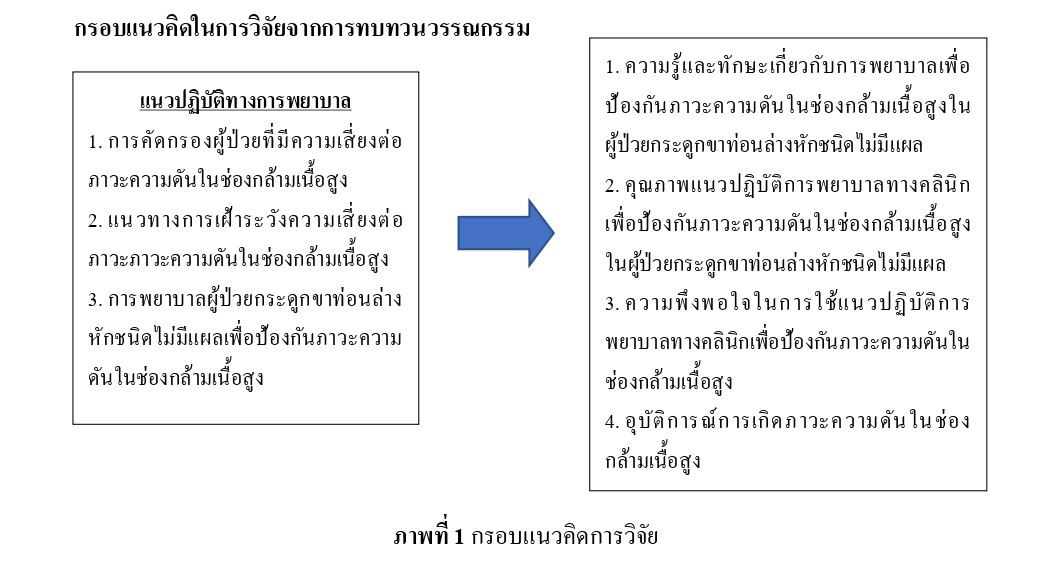The Effect of the Clinical Nursing Practice Guideline to Prevent the Compartment Syndrome among Patients, Suffering from Closed Fracture Lower Leg
Adchara Khammathit
Keywords:
Clinical Nursing Practice Guideline, Closed fracture, Compartment syndrome, Fracture of lower legAbstract
This one group pre-post test, quasi-experimental study, aimed to determine the effectiveness of the clinical nursing practice guideline to prevent the compartment syndrome among patients, suffering from closed fracture lower leg. The research samples were 10 registered nurses at the orthopedic ward and 15 patients who were diagnosed as a closed facture lower leg.
The experimental instrument was the clinical nursing practice guideline to prevent the compartment syndrome, developed by the researcher. Data were collected by 1) demographic questionnaire, 2) the knowledge and nursing skill questionnaire, 3) the quality of clinical nursing practice assessment, and 4) the satisfaction questionnaire. Wilcoxon Match Paired Test was employed for data analysis. The result revealed that the participants had the knowledge and nursing skills at post intervention significantly higher than baseline (p ≤ 0.05). The participants indicated that the overall quality of clinical nursing practice guideline was at high level (x̅ = 8.20, S.D. = 0.14). Knowledge of nursing care was showed at the highest score while the level of difficulty was indicated at lowest score. The clinical nursing practice guideline was satisfied by the participant at high level (x̅) = 8.70, S.D. = 0.78). In addition, while conducting the clinical nursing practice guideline through the 15 patients, there was no incident of compartment syndrome. The results recommend that the feasibility of CNPG was illustrated, and it should be implemented through the orthopedic department in other hospitals to enhance the quality of nursing care.
References
Aromataris, E., & Munn, Z. (Editors). (2020). JBI Manual for Evidence Synthesis. JBI, Retrieved May 20, 2022 from https://synthesismanual.jbi.global. DOI: 10.46658/JBIMES-20-01
Guo, J., Yin, Y., Jin, L., Zhang, R., Hou, Z., & Zhang, Y. (2019). Acute compartment syndrome: Cause, diagnosis, and new viewpoint. Medicine (Baltimore), 98 (27), e16260. DOI: 10.1097/MD.0000000000016260.
Khammathit, A., & Makrat, M. (2016). Using the systematic review to provide a complete summary on a research question in evidence-based practice: A 3 step method, The Southern College Network Journal of Nursing and Public Health, 3(3), 249 - 259.
Khammathit, A. (2021). The evidence-based approach in health care management applied to nursing, The Southern College Network Journal of Nursing and Public Health, 8(2), 315 - 328.
Kraisriwattana, S. (2020). Nursing practice guideline development for surveillance of compartment syndrome in orthopedic department Udonthani Hospital, Udonthani Hospital Medical Journal, 28(2), 192 - 202.
McMillan, T.E., Gardner, W.T., & Schmidt, A.H., (2019). Johnstone AJ. Diagnosing acute compartment syndrome-where have we got to?. International Orthopedics, 43(11), 2429 - 2435. DOI: 10.1007/s00264-019-04386-y
Medical record department Udonthani hospital. (2022). Patient visit statistic report, Udonthani Hospital, N.P. (in Thai).
Mortensen, S.J., Orman, S., Serino, J., Mohamadi, A., Nazarian, A., & von Keudell, A. (2021) Factors Associated with Development of Traumatic Acute Compartment Syndrome: A Systematic Review and Meta-analysis. The archives of bone and joint surgery, 9(3), 263 - 271. DOI: 10.22038/abjs.2020.46684.2284.
Orthopedic department Udonthani hospital (2019). Annual report of Orthopedic department, Udonthani hospital; 2017-2019, N.P. (in Thai).
Osborn, C., Patrick, M., Schmidt, M.D., & Andrew, H. (2020) Management of Acute Compartment Syndrome. Journal of the American Academy of Orthopedic Surgeons, 28(3), 108 -114. DOI: 10.5435/JAAOS-D-19-00270
Pechar, J., & Lyons, M. M. (2016). Acute compartment syndrome of the lower leg: a review. The Journal for Nurse Practitioners, 12(4), 265 – 270. DOI: 10.1016/j.nurpra.2015.10.013
Pokharel, K. (2020). Knowledge regarding prevention of post traumatic compartment syndrome of limbs among nurses of a teaching hospital. Journal of Patan Academy of Health Sciences, 7(3), 84-94. DOI: 10.3126/jpahs.v7i3.33832
Stella, M., Santolini, E., Sanguineti, F., Felli, L., Vicenti, G., Bizzoca, D., & Santolini, F. (2019). Aetiology of trauma-related acute compartment syndrome of the leg: A systematic review. Injury, 50, S57 -S64. DOI: 10.1016/j.injury.2019.01.047
Taiwong, A., Baothong, K., Palachai, T., Paenghom, C., & Nuchphool, J. (2019). Compartment Syndrome among Orthopedic Patient: Nurse’ Roles in Assessment and Prevention. Journal of The Royal Thai Army Nurses, 19, 17 - 24.
Thanapanich, T. (2019). Nursing care of closed fracture left Tibia with compartment syndrome: case study, Singburi hospital journal, 28(2), 77 - 96.
Wang, T., Guo, J., Long, Y., & Hou, Z. (2023). Predictors of acute compartment syndrome in with tibial fractures: a meta-analysis. International Orthopedics (SICOT), 47, 51 - 65. DOI: 10.1007/s00264-022-05643-3

Downloads
Published
How to Cite
Issue
Section
License
Copyright (c) 2024 Princess of Naradhiwas University Journal

This work is licensed under a Creative Commons Attribution-NonCommercial-NoDerivatives 4.0 International License.



